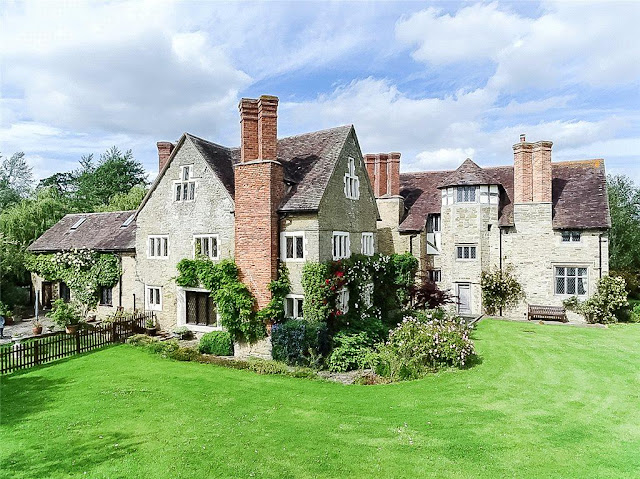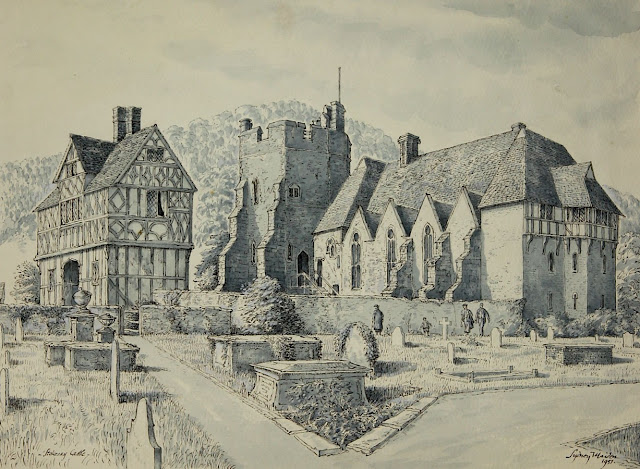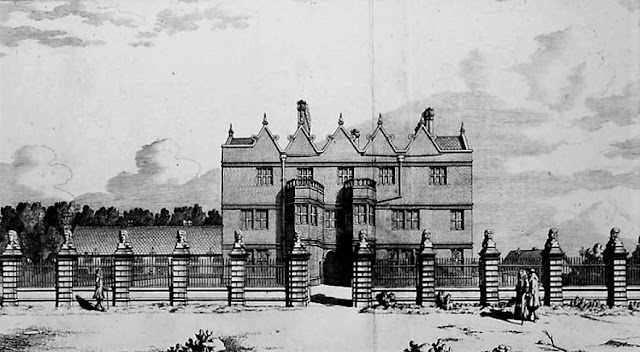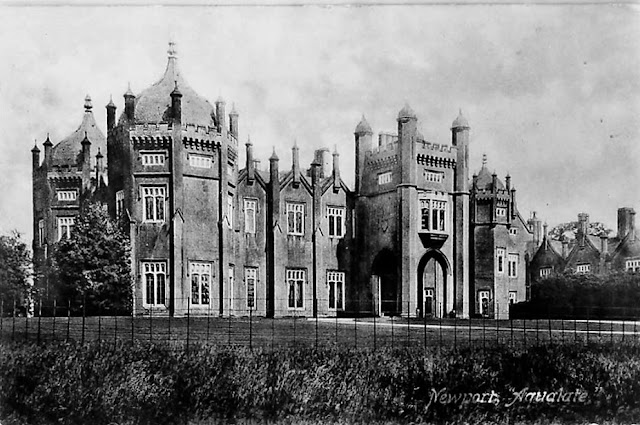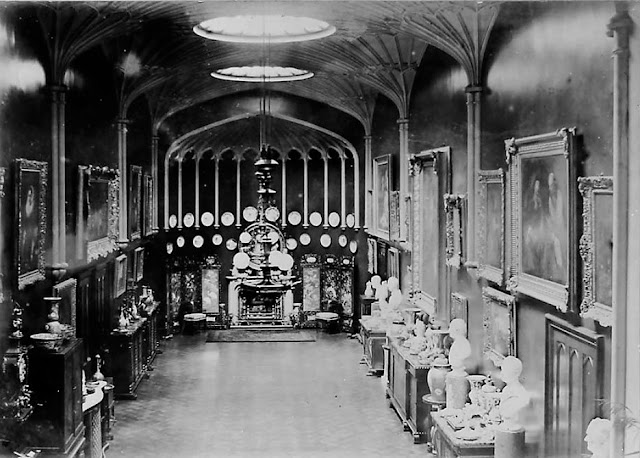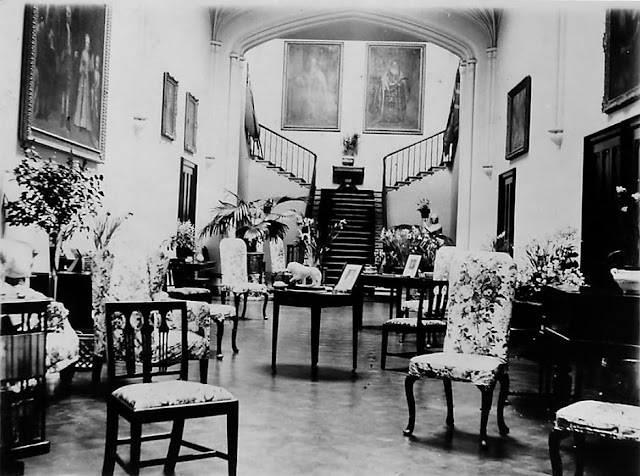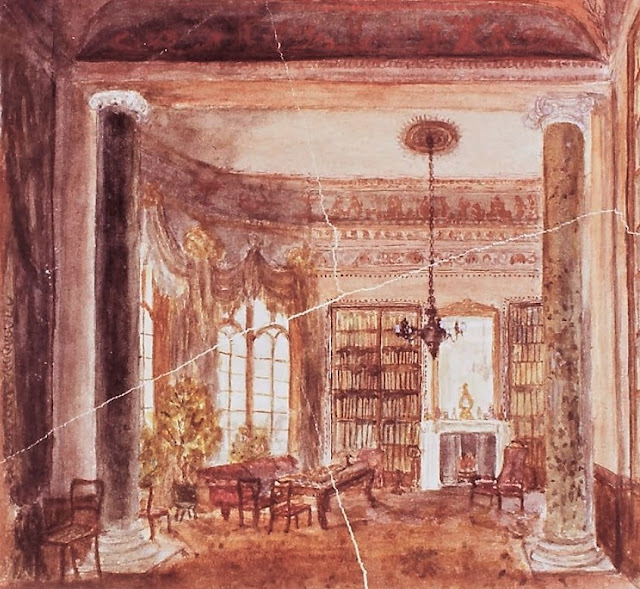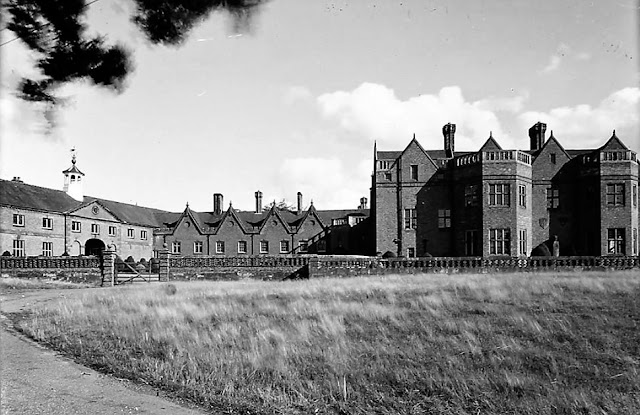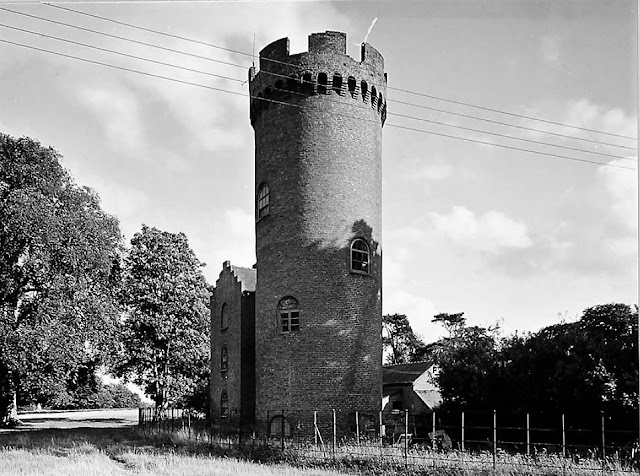 |
| Bale of Carlton Curlieu |
Sir John sent his eldest son, George Bale (c.1572-1616) to Oxford University and Lincoln's Inn to be educated as a gentleman and equipped to take his place at the head of a rising dynasty, while his five younger sons were probably all apprenticed to London merchants. Sadly, George and several of his brothers predeceased their father, and only the two youngest, Edmund and William, seem to have survived their mother, who died in 1629/30. They jointly inherited the manor of Saddington, which they sold in 1640. The rest of the family property passed in 1622 to George Bale's sons, Sir John Bale (1594-c.1660), who was knighted in 1624 during his year as High Sheriff and who built a new house at Carlton Curlieu in 1636, and Valentine Bale (c.1596-1644), who settled at Humberstone near Leicester, where his wife was the heiress to the property of her father, Tobias Chippingdale.
The Bales continued to be closely associated with the Hastings family throughout the early 17th century, and joined them in support of the Royalist cause during the Civil War. Although Lord Huntingdon exercised considerable power and influence, his ardent Royalist views were in a decided minority in the county, and this, together with the fact that the position of Leicestershire across several of the major north-south routes through the kingdom made it important territory for both sides to control, meant the position of the local Royalists was difficult from the beginning. In June 1642 Sir John Bale was one of those directed by the King to muster the militia forces of the county, and this usurping of a power which Parliament had recently abrogated to itself led to his being summoned to Westminster on charges of treason, although these seem later to have been forgotten in the heat of the ensuing conflict. Sir John and his three eldest sons, John (who was made a baronet in 1643), William and Thomas all took an active part in the fighting in and around the county. William became a Lieutanant-Colonel in the Earl of Huntingdon's regiment, and all four of them may have been part of the garrison at Ashby Castle at different times. Certainly Thomas Bale was among those killed in action at Ashby in 1644, and Sir John's brother Edmund, who was buried in the same year, may have been another victim, though this is less certain. In 1646 the Royalists reluctantly laid down their arms and Ashby Castle was surrendered, and the process of seizing the assets of leading Royalists and fining others began. Frustratingly little information survives about how the Bales were treated at this time, but since they raised a succession of mortgages on the estate in the late 1640s and early 1650s, and agreed the sale of Carlton Curlieu to a London lawyer in return for the payment of debts amounting to over £16,000, it seems likely that they were heavily fined. The sale of the manor dragged on until 1662 (and the price rose to £23,000), and by the time it was finally completed in 1662, Sir John Bale, kt. was dead and it was his son, Sir John Bale (c.1617-79), 1st bt. who pushed it through. This Sir John was among the many Royalists who petitioned King Charles II for some relief from their debts when he was restored to the throne in 1660, but Charles lacked the resources to offer anything much more than sympathy and thanks, and after 1662 Sir John retired to Humberstone, where he died in 1679. The Bales were thus one of the few families across the country who were ruined and permanently dispossessed of their estates as a result of their Civil War activities.
Carlton Curlieu Hall, Leicestershire
Carlton Curlieu Hall is a substantial but compact L-shaped house with a core built for Sir John Bale in about 1636, according to a datestone on the back of the house. There seems to be no record of the appearance of the house in the time of the Bales, and most of what we see today was built after Sir Geoffrey Palmer, 1st bt., a Royalist who was imprisoned during the Commonwealth period but survived to become Charles II's attorney general, bought the estate in 1664. He undertook a major remodelling around 1671 (date on rainwater heads on the west front), and it was further modernised c.1820 for the Rev. Henry Palmer, who seems to have lived here after the death of his father in 1817. |
| Carlton Curlieu Hall: the house as altered by Sir Geoffrey Palmer, c.1671, from Nichols' History of Leicestershire (1798) |
 |
| Carlton Curlieu Hall: entrance front and side elevation in the 1980s. |
Inside, the hall runs south from the porch and has panelling with a strapwork frieze moved from a bedroom elsewhere in the house. There is bolection-moulded panelling in the drawing room in the middle of the south front and a room north of the hall. The dining room is along the east side and was formed out of two smaller rooms, probably in 1820. The staircase is of the 1630s period with symmetrical balusters and knob finials.
Descent: Sir John Bale (c.1551-1622), kt.; to grandson, Sir John Bale (1594-c.1660), kt.; to son, Sir John Bale (c.1617-79), 1st bt.; sold 1654-62 to John Prettyman; sold 1664 to Sir Geoffrey Palmer (1598-1670), 1st bt.; to son, Sir Lewis Palmer (d. 1714), 2nd bt.; to son, Sir Geoffrey Palmer (1655-1732), 3rd bt.; to son, Sir Thomas Palmer (d. 1765), 4th bt.; to son, Sir John Palmer (1735-1817), 5th bt., who rebuilt East Carlton Hall (Northants) and made that his seat; to younger son, Rev. Henry Palmer (1780-1856), who later leased the house to Lady Hazlerigg (fl. 1846); it was then let until 1938, with tenants including W.W. Taillby (fl. 1857-75); Capt. Sutton (fl. 1876); Francis E. Bigge (fl. 1878-84); Mr C. MacNeill (fl. 1898) and Sir Keith Fraser (d. 1935) and his widow (1916-38); reverting in 1938 to Sir Geoffrey Frederick Neil Palmer (1893-1951), 11th bt.; to son, Sir Geoffrey Christopher John Palmer (b. 1936), 12th bt.
Bale, John (d. 1570). Elder son of John Bale of Carlton Curlieu, yeoman. Yeoman farmer at Carlton Curlieu. Through his purchases of land he rose in social status and was styled a gentleman in 1557, though he still called himself a yeoman in his will. He married Joan Pettie (fl. 1570) but had no issue.
He purchased 1,787 acres of land in Carlton Curlieu, Burton Overy and the surrounding parishes between 1547 and 1563.
He died between March and May 1570; his will was proved 27 May 1570. His widow survived him, but her date of death is unknown.
Bale, Robert. Second son of John Bale of Carlton Curlieu, yeoman. Yeoman farmer. He married Joan Gamble of Burton Overy and had issue:
(1) Edward Bale; died without issue before 1570;
(2) Sir John Bale (c.1551-1622), kt. (q.v.);
(3) Katherine Bale (d. 1610); married, after 1570, Thomas Saunderson (d. 1606 or 1616) of Whetstone (Leics); buried at Whetstone, 23 November 1610.
He lived at Carlton Curlieu.
He probably died before 1570. His wife's date of death is unknown.
Bale, Sir John (c.1551-1622), kt. Second son of Robert Bale of Carlton Curlieu and his wife Joan Gamble of Burton Overy, born about 1551. A gentleman farmer who was described by contemporaries as 'a henchman' of the Earl of Huntingdon, a connection which led to his appointment as a JP for Leicestershire in 1611 and, no doubt, to his being knighted at Ashby-de-la-Zouch, 2 September 1617. He married, about 1572, Frances (c.1549-1630), daughter of Bernard Brocas of Beaurepaire (Hants) and had issue:
(1) George Bale (c.1572-1616) (q.v.);
(2) Robert Bale (d. by 1613); married Alice Cooper (b. 1579) of Thurmaston (who m2, 7 February 1613, Rev. Anthony Cade (1564-1641), vicar of Billesdon (Leics) and had issue two daughters) but died without issue before 1613;
(3) John Bale (d. c.1622), of Saddington; probably a merchant as he was preparing to travel 'beyond the seas a long and dangerous journey' in March 1617; his will was proved in the PCC, 21 June 1622;
(4) Francis Bale (fl. 1619), of London and Weybridge (Surrey); East India merchant; married, before 1614, Margaret, daughter of John Manning of London, merchant, and had issue two sons and two daughters; living in 1619;
(5) Edmund Bale (d. 1644), of Saddington; probably the man of that name who was one of the wardens of the Feltmakers Company in London in 1622; with his younger brother, he sold the manor of Saddington in 1640; married, 9 May 1609 at Peatling Magna (Leics), Jese alias Jocosa alias Joyce (fl. 1616), daughter of Sir Richard Roberts, kt., of Sutton Cheney, and had issue three sons and four daughters; buried at Ashby-de-la-Zouch, 7 June 1644;
(6) William Bale (fl. 1640); named in his mother's will; with his elder brother, sold the manor of Saddington in 1640.
He inherited lands in and around Carlton Curlieu from his uncle John Bale (d. 1570) and acquired the manor of Carlton Curlieu in 1575 from his father-in-law and Sir George Turpyn. Between 1599 and 1607 he and his eldest son converted most of the arable land they owned to pasture and depopulated the village of Carlton Curlieu. In 1606 he bought the manor of Saddington.
He died 10 March 1621/2 and was buried at Carlton Curlieu, where he and his wife are commemorated by a chest tomb. His wife died 27 February 1629/30; her will was proved at Leicester.
Bale, George (c.1572-1616). Eldest son of Sir John Bale, kt., and his wife Frances, daughter of Bernard Brocas of Beaurepaire (Hants). Educated at Jesus College, Oxford (matriculated 1585/6) and Lincoln's Inn (admitted 1591). He married Elizabeth (d. 1642), daughter of Valentine Hartopp of Burton Lazars, and had issue:
(1) Frances Bale (b. 1592?), perhaps the person of this name baptised at Melton Mowbray, 25 June 1592; married William Roberts of Barwell and had issue five children;
(2) Sir John Bale (1594-c.1660), kt. (q.v.);
(3) Valentine Bale (c.1596-1644), of Humberstone, born about 1596; educated at Emmanuel College, Cambridge (matriculated 1613) and Grays Inn (admitted 1615/6); married, before 1618, Elizabeth (d. 1672), daughter and heir of Tobias Chippingdale of Humberstone, and had issue two sons and four daughters; buried at Humberstone, 30 November 1644; will proved 4 March 1644/5.
He died in about October 1616; his will was proved in the PCC, 21 November 1616. His widow married 2nd, Sir William Roberts (d. 1633) of Sutton Cheney, but had no further issue; she died at Humberstone in 1642 and she and her second husband are commemorated by monuments in the church at Sutton Cheney; her will was proved at Leicester, 13 August 1642.
Bale, Sir John (1594-c.1660), kt. Elder son of George Bale and his wife Elizabeth, daughter of Valentine Hartopp of Burton Lazars, baptised at Carlton Curlieu, 18 October 1594. High Sheriff of Leicestershire, 1624. He was knighted by King James I at Belvoir Castle, 4 August 1624. At the start of the Civil War, he was one of the Royalists to whom the King's commission of array for Leicestershire was addressed in June 1642*, and he helped to muster men from Derbyshire, Leicestershire and Lincolnshire at Loughborough, from whence they marched to Leicester in a show of strength; Parliament issued articles of impeachment against him and three others for this action, but there is no evidence that the matter went any further. He was present at the siege of Ashby-de-la-Zouch Castle at which his son Thomas was killed and was fined for his delinquency (discharged, 1648). He married 1st, about 1615, Emma (d. 1630), daughter of William Halford of Welham, and 2nd, 6 October 1631 at Gotham (Notts), Elizabeth (b. 1599), daughter of John Bainbrigge of Lockington and widow of John St. Andrew (d. 1625) of Gotham, and had issue:
(1.1) Sir John Bale (c.1617-79), 1st bt. (q.v.);
(1.2) Lt-Col. William Bale (1618-89), of Humberstone, born 1618; educated at Melton Mowbray, Lincoln College, Oxford (matriculated 1635), St. John's College, Cambridge (admitted 1636) and Inner Temple (admitted 1637); an officer in the Royalist army (Lt-Col. of Hastings' Horse and later seconded to Gervaise Lucas, the Governor of Belvoir Castle); he was fined for his delinquency (discharged, 1648); married, 27 March 1653, Elizabeth (d. 1682), daughter of William Jervis of Peatling Magna (Leics), and had issue one son (Samuel, who died unmarried and without issue in 1687 and was buried at Humberstone); buried at St Mary de Castro, Leicester, 6 April 1689;
(1.3) George Bale (b. c.1620); died without issue and probably in infancy;
(1.4) Francis Bale (c. 1621-31); buried at Carlton Curlieu, 14 December 1631;
(1.5) Frances Bale (1622-99), born 16 July and baptised at Carlton Curlieu, 23 July 1622; married, 1652 at Carlton Curlieu, Maj. William Warner (d. 1682) of Lubenham (Leics), gent., and had issue three sons and three daughters; buried at Lubenham, 10 March 1698/9;
(1.6) Thomas Bale (c.1624-44), born about 1624; probably the man of this name who matriculated at Magdalene College, Cambridge in 1642, but if so his education would have been disrupted by the Civil War; died unmarried when he was killed while serving in the Royalist cause at Ashby-de-la-Zouch; buried at Ashby, 6 November 1644;
(1.7) Samuel Bale (1625-79), baptised at Carlton Curlieu, 1625; lived at Humberstone; died unmarried in early November 1679; will proved at Leicester, 13 November 1679;
(1.8) Richard Bale (d. 1658); buried at Carlton Curlieu, 27 January 1657/8;
(2.1) Anne Bale (d. 1633); died in infancy and was buried at Carlton Curlieu, 12 November 1633;
(2.2) Sarah Bale (b. 1633), baptised at Carlton Curlieu, 8 November 1633; probably died young.
He inherited Carlton Curlieu from his grandfather in 1622, but lived at first at Saddington. He built a new house at Carlton Curlieu in 1636. He and his son sold the house, advowson and manor of Carlton Curlieu to John Prettyman between 1654 and 1662 in return for payment of their debts totalling £16,090, though the purchase price later increased to £23,000.
He died after July 1660 and seems to have been dead by July 1661. His first wife died 27 June 1630. His widow was living in 1661.
* It is normally stated that the man named in Commission of Array was his son John, but the Commission clearly names 'Sir John Bale' and the son did not become 'Sir John' until he was made a baronet the following year.
Bale, Sir John (c.1617-79), 1st bt. Eldest son of Sir John Bale, kt., by his first wife Emma, daughter of William Halford of Welham, born about 1617. Educated at Great Glen, Stamford, and Sidney Sussex College, Cambridge (matriculated 1634). He was created a baronet, 9 November 1643. During the Civil War he was an active and enthusiastic Royalist: his house at Carlton Curlieu was garrisoned; he was present at the siege of Ashby-de-la-Zouch Castle at which his brother was killed; and he was a commander in the fleet of which Prince Rupert was Admiral. In 1653 he visited Antwerp with Luke Whittington. In 1660, he petitioned the King for relief from the great debts the had incurred through his loyalty. He was heavily fined for his delinquency by Parliament (discharged, 1648). In 1662 he was named as one of the Commissioners for distributing a Crown grant among loyal and indigent officers in Leicestershire and in 1663 by was a Commissioner for the Subsidy. He married, c.1651, Jane* (d. 1652), daughter and heir of Sir Thomas Puckering, bt., of Warwick, but had no surviving issue.
His wife was heir to The Priory estate at Warwick, but after her death this passed to her cousin, Sir Henry Puckering alias Warner. Sir John and his father sold the house, advowson and manor of Carlton Curlieu to John Prettyman between 1654 and 1662 in return for payment of their debts totalling £16,090, though the purchase price later increased to £23,000.
He was buried at Humberstone (Leics), 11 September 1679**, whereupon the baronetcy became extinct; his will was proved at Leicester, 25 October 1679. His wife died in childbirth, 27 January 1651/2; administration of her goods was granted to her husband, 10 February 1651/2.
*In 1649, Jane, who was an orphan and heiress, had been abducted by Joseph Walsh and taken to Flanders, where she was confined in a nunnery until she agreed to marry him; having obtained her liberty she came to England and took legal measures to annul the marriage; her attackers were tried in absentio at Maidstone and the marriage was annulled.
** Contrary to most previous accounts, which have stated erroneously that he died about 1653/4.
Burke's Extinct and Dormant Baronetcies, 2nd ed., 1841, p. 33; John Nichols, The History and Antiquities of the County of Leicester (1795-1815), vol. 2, part 2, pp. 539 ff; D. Lysons, The environs of London: Hertfordshire, Essex and Kent, 1796, p. 326; W.G. Hoskins, 'The Leicestershire farmer in the 16th century', Trans. Leicestershire Archaeological Society, vol. 24, 1941-42, pp. 33-94; L.A. Parker, 'The depopulation returns for Leicestershire in 1607', Trans. Leicestershire Archaeological Society, 1947, pp. 229-92; VCH Leicestershire, vol. 5, 1964, pp. 77-81, 282-87; M. Bennett, 'The Royalist war effort in the North Midlands, 1642-46', PhD thesis, Loughborough, 1986.
Bale of Carlton Curlieu: some 17th century deeds and legal papers can be found among the papers of the successor Palmer family of Carlton Curlieu [Record Office for Leicestershire, Leicester & Rutland, DE 1110].
Per pale, vert and gules, an eagle displayed argent, armed and beaked or.
The loss of the parish registers for Carlton Curlieu before 1749 means that much basic genealogical information for this family is missing; the few records that are given are taken from the highly imperfect sequence of bishops' transcripts and from entries noticed in Nichols' History of Leicestershire. If anyone has additional information from other sources, please get in touch.
It is possible that no portraits of members of this family survive, but I should be most interested to see any images that do exist.
If anyone has studied the documentation relating to the Bales' civil war fines and the sale of the Carlton Curlieu estate, and is able to offer a clearer account of these matters than is given here, I would be most grateful for the information.
This post was first published 30 August 2018.
Bale family of Carlton Curlieu, baronets
Bale, John (d. 1570). Elder son of John Bale of Carlton Curlieu, yeoman. Yeoman farmer at Carlton Curlieu. Through his purchases of land he rose in social status and was styled a gentleman in 1557, though he still called himself a yeoman in his will. He married Joan Pettie (fl. 1570) but had no issue.
He purchased 1,787 acres of land in Carlton Curlieu, Burton Overy and the surrounding parishes between 1547 and 1563.
He died between March and May 1570; his will was proved 27 May 1570. His widow survived him, but her date of death is unknown.
Bale, Robert. Second son of John Bale of Carlton Curlieu, yeoman. Yeoman farmer. He married Joan Gamble of Burton Overy and had issue:
(1) Edward Bale; died without issue before 1570;
(2) Sir John Bale (c.1551-1622), kt. (q.v.);
(3) Katherine Bale (d. 1610); married, after 1570, Thomas Saunderson (d. 1606 or 1616) of Whetstone (Leics); buried at Whetstone, 23 November 1610.
He lived at Carlton Curlieu.
He probably died before 1570. His wife's date of death is unknown.
Bale, Sir John (c.1551-1622), kt. Second son of Robert Bale of Carlton Curlieu and his wife Joan Gamble of Burton Overy, born about 1551. A gentleman farmer who was described by contemporaries as 'a henchman' of the Earl of Huntingdon, a connection which led to his appointment as a JP for Leicestershire in 1611 and, no doubt, to his being knighted at Ashby-de-la-Zouch, 2 September 1617. He married, about 1572, Frances (c.1549-1630), daughter of Bernard Brocas of Beaurepaire (Hants) and had issue:
(1) George Bale (c.1572-1616) (q.v.);
(2) Robert Bale (d. by 1613); married Alice Cooper (b. 1579) of Thurmaston (who m2, 7 February 1613, Rev. Anthony Cade (1564-1641), vicar of Billesdon (Leics) and had issue two daughters) but died without issue before 1613;
(3) John Bale (d. c.1622), of Saddington; probably a merchant as he was preparing to travel 'beyond the seas a long and dangerous journey' in March 1617; his will was proved in the PCC, 21 June 1622;
(4) Francis Bale (fl. 1619), of London and Weybridge (Surrey); East India merchant; married, before 1614, Margaret, daughter of John Manning of London, merchant, and had issue two sons and two daughters; living in 1619;
(5) Edmund Bale (d. 1644), of Saddington; probably the man of that name who was one of the wardens of the Feltmakers Company in London in 1622; with his younger brother, he sold the manor of Saddington in 1640; married, 9 May 1609 at Peatling Magna (Leics), Jese alias Jocosa alias Joyce (fl. 1616), daughter of Sir Richard Roberts, kt., of Sutton Cheney, and had issue three sons and four daughters; buried at Ashby-de-la-Zouch, 7 June 1644;
(6) William Bale (fl. 1640); named in his mother's will; with his elder brother, sold the manor of Saddington in 1640.
He inherited lands in and around Carlton Curlieu from his uncle John Bale (d. 1570) and acquired the manor of Carlton Curlieu in 1575 from his father-in-law and Sir George Turpyn. Between 1599 and 1607 he and his eldest son converted most of the arable land they owned to pasture and depopulated the village of Carlton Curlieu. In 1606 he bought the manor of Saddington.
He died 10 March 1621/2 and was buried at Carlton Curlieu, where he and his wife are commemorated by a chest tomb. His wife died 27 February 1629/30; her will was proved at Leicester.
Bale, George (c.1572-1616). Eldest son of Sir John Bale, kt., and his wife Frances, daughter of Bernard Brocas of Beaurepaire (Hants). Educated at Jesus College, Oxford (matriculated 1585/6) and Lincoln's Inn (admitted 1591). He married Elizabeth (d. 1642), daughter of Valentine Hartopp of Burton Lazars, and had issue:
(1) Frances Bale (b. 1592?), perhaps the person of this name baptised at Melton Mowbray, 25 June 1592; married William Roberts of Barwell and had issue five children;
(2) Sir John Bale (1594-c.1660), kt. (q.v.);
(3) Valentine Bale (c.1596-1644), of Humberstone, born about 1596; educated at Emmanuel College, Cambridge (matriculated 1613) and Grays Inn (admitted 1615/6); married, before 1618, Elizabeth (d. 1672), daughter and heir of Tobias Chippingdale of Humberstone, and had issue two sons and four daughters; buried at Humberstone, 30 November 1644; will proved 4 March 1644/5.
He died in about October 1616; his will was proved in the PCC, 21 November 1616. His widow married 2nd, Sir William Roberts (d. 1633) of Sutton Cheney, but had no further issue; she died at Humberstone in 1642 and she and her second husband are commemorated by monuments in the church at Sutton Cheney; her will was proved at Leicester, 13 August 1642.
Bale, Sir John (1594-c.1660), kt. Elder son of George Bale and his wife Elizabeth, daughter of Valentine Hartopp of Burton Lazars, baptised at Carlton Curlieu, 18 October 1594. High Sheriff of Leicestershire, 1624. He was knighted by King James I at Belvoir Castle, 4 August 1624. At the start of the Civil War, he was one of the Royalists to whom the King's commission of array for Leicestershire was addressed in June 1642*, and he helped to muster men from Derbyshire, Leicestershire and Lincolnshire at Loughborough, from whence they marched to Leicester in a show of strength; Parliament issued articles of impeachment against him and three others for this action, but there is no evidence that the matter went any further. He was present at the siege of Ashby-de-la-Zouch Castle at which his son Thomas was killed and was fined for his delinquency (discharged, 1648). He married 1st, about 1615, Emma (d. 1630), daughter of William Halford of Welham, and 2nd, 6 October 1631 at Gotham (Notts), Elizabeth (b. 1599), daughter of John Bainbrigge of Lockington and widow of John St. Andrew (d. 1625) of Gotham, and had issue:
(1.1) Sir John Bale (c.1617-79), 1st bt. (q.v.);
(1.2) Lt-Col. William Bale (1618-89), of Humberstone, born 1618; educated at Melton Mowbray, Lincoln College, Oxford (matriculated 1635), St. John's College, Cambridge (admitted 1636) and Inner Temple (admitted 1637); an officer in the Royalist army (Lt-Col. of Hastings' Horse and later seconded to Gervaise Lucas, the Governor of Belvoir Castle); he was fined for his delinquency (discharged, 1648); married, 27 March 1653, Elizabeth (d. 1682), daughter of William Jervis of Peatling Magna (Leics), and had issue one son (Samuel, who died unmarried and without issue in 1687 and was buried at Humberstone); buried at St Mary de Castro, Leicester, 6 April 1689;
(1.3) George Bale (b. c.1620); died without issue and probably in infancy;
(1.4) Francis Bale (c. 1621-31); buried at Carlton Curlieu, 14 December 1631;
(1.5) Frances Bale (1622-99), born 16 July and baptised at Carlton Curlieu, 23 July 1622; married, 1652 at Carlton Curlieu, Maj. William Warner (d. 1682) of Lubenham (Leics), gent., and had issue three sons and three daughters; buried at Lubenham, 10 March 1698/9;
(1.6) Thomas Bale (c.1624-44), born about 1624; probably the man of this name who matriculated at Magdalene College, Cambridge in 1642, but if so his education would have been disrupted by the Civil War; died unmarried when he was killed while serving in the Royalist cause at Ashby-de-la-Zouch; buried at Ashby, 6 November 1644;
(1.7) Samuel Bale (1625-79), baptised at Carlton Curlieu, 1625; lived at Humberstone; died unmarried in early November 1679; will proved at Leicester, 13 November 1679;
(1.8) Richard Bale (d. 1658); buried at Carlton Curlieu, 27 January 1657/8;
(2.1) Anne Bale (d. 1633); died in infancy and was buried at Carlton Curlieu, 12 November 1633;
(2.2) Sarah Bale (b. 1633), baptised at Carlton Curlieu, 8 November 1633; probably died young.
He inherited Carlton Curlieu from his grandfather in 1622, but lived at first at Saddington. He built a new house at Carlton Curlieu in 1636. He and his son sold the house, advowson and manor of Carlton Curlieu to John Prettyman between 1654 and 1662 in return for payment of their debts totalling £16,090, though the purchase price later increased to £23,000.
He died after July 1660 and seems to have been dead by July 1661. His first wife died 27 June 1630. His widow was living in 1661.
* It is normally stated that the man named in Commission of Array was his son John, but the Commission clearly names 'Sir John Bale' and the son did not become 'Sir John' until he was made a baronet the following year.
Bale, Sir John (c.1617-79), 1st bt. Eldest son of Sir John Bale, kt., by his first wife Emma, daughter of William Halford of Welham, born about 1617. Educated at Great Glen, Stamford, and Sidney Sussex College, Cambridge (matriculated 1634). He was created a baronet, 9 November 1643. During the Civil War he was an active and enthusiastic Royalist: his house at Carlton Curlieu was garrisoned; he was present at the siege of Ashby-de-la-Zouch Castle at which his brother was killed; and he was a commander in the fleet of which Prince Rupert was Admiral. In 1653 he visited Antwerp with Luke Whittington. In 1660, he petitioned the King for relief from the great debts the had incurred through his loyalty. He was heavily fined for his delinquency by Parliament (discharged, 1648). In 1662 he was named as one of the Commissioners for distributing a Crown grant among loyal and indigent officers in Leicestershire and in 1663 by was a Commissioner for the Subsidy. He married, c.1651, Jane* (d. 1652), daughter and heir of Sir Thomas Puckering, bt., of Warwick, but had no surviving issue.
His wife was heir to The Priory estate at Warwick, but after her death this passed to her cousin, Sir Henry Puckering alias Warner. Sir John and his father sold the house, advowson and manor of Carlton Curlieu to John Prettyman between 1654 and 1662 in return for payment of their debts totalling £16,090, though the purchase price later increased to £23,000.
He was buried at Humberstone (Leics), 11 September 1679**, whereupon the baronetcy became extinct; his will was proved at Leicester, 25 October 1679. His wife died in childbirth, 27 January 1651/2; administration of her goods was granted to her husband, 10 February 1651/2.
*In 1649, Jane, who was an orphan and heiress, had been abducted by Joseph Walsh and taken to Flanders, where she was confined in a nunnery until she agreed to marry him; having obtained her liberty she came to England and took legal measures to annul the marriage; her attackers were tried in absentio at Maidstone and the marriage was annulled.
** Contrary to most previous accounts, which have stated erroneously that he died about 1653/4.
Sources
Burke's Extinct and Dormant Baronetcies, 2nd ed., 1841, p. 33; John Nichols, The History and Antiquities of the County of Leicester (1795-1815), vol. 2, part 2, pp. 539 ff; D. Lysons, The environs of London: Hertfordshire, Essex and Kent, 1796, p. 326; W.G. Hoskins, 'The Leicestershire farmer in the 16th century', Trans. Leicestershire Archaeological Society, vol. 24, 1941-42, pp. 33-94; L.A. Parker, 'The depopulation returns for Leicestershire in 1607', Trans. Leicestershire Archaeological Society, 1947, pp. 229-92; VCH Leicestershire, vol. 5, 1964, pp. 77-81, 282-87; M. Bennett, 'The Royalist war effort in the North Midlands, 1642-46', PhD thesis, Loughborough, 1986.
Location of archives
Bale of Carlton Curlieu: some 17th century deeds and legal papers can be found among the papers of the successor Palmer family of Carlton Curlieu [Record Office for Leicestershire, Leicester & Rutland, DE 1110].
Coat of arms
Per pale, vert and gules, an eagle displayed argent, armed and beaked or.
Notes about missing information and help wanted with this entry
The loss of the parish registers for Carlton Curlieu before 1749 means that much basic genealogical information for this family is missing; the few records that are given are taken from the highly imperfect sequence of bishops' transcripts and from entries noticed in Nichols' History of Leicestershire. If anyone has additional information from other sources, please get in touch.
It is possible that no portraits of members of this family survive, but I should be most interested to see any images that do exist.
If anyone has studied the documentation relating to the Bales' civil war fines and the sale of the Carlton Curlieu estate, and is able to offer a clearer account of these matters than is given here, I would be most grateful for the information.
Revision and acknowledgements
This post was first published 30 August 2018.


